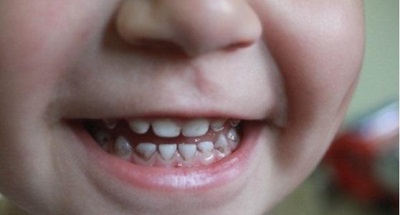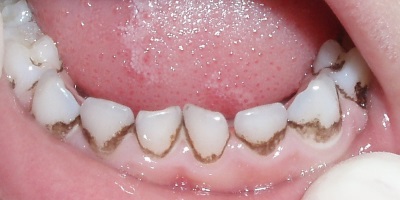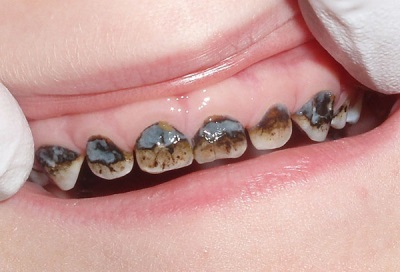Causes of black plaque on the teeth of children
Attentive parents will immediately notice if the child's teeth have changed their color. If it is a pale yellow color, then this shade does not cause concern, but a dramatic change in the color of the teeth, say, black, is always alarming. Why can the teeth of babies turn black and what should parents do in this case?
What does it look like?
Often the plaque on the black teeth is an uneven dark edging, distributed over all the teeth. Less commonly, it is represented by black specks. In most cases, blackening is noticed on the inner side of the dentition, but black spots can appear on the outer surfaces of the teeth. At the same time, such a plaque cannot be removed with the help of ordinary tooth brushing.
Changes occur at any age, so a one-year-old child, a child aged 3 years, a younger student, and a teenager can acquire black coloring of the teeth. In this case, color changes may appear gradually, and in some children, the teeth turn black in just a few days.
The reasons
The deposits that appear on the enamel of the teeth are uncleaned food debris and dead particles of the mucous membrane. They are joined by beneficial and pathogenic microorganisms. If such deposits are not removed in time, this leads to their accumulation and compaction, and their color may become black due to:
- Adverse effects on tooth primordia during pregnancy. Such effects may be a lack of calcium and an excess of iron in the diet of the expectant mother, a woman's taking certain medications, or severe viral infections transferred during gestation.
- The appearance of dysbacteriosis in the crumbs due to a change in diet or taking antibiotics. Also problems with digestion can be caused by chronic diseases of the intestines and liver.
- The activity of particular pigment-forming bacteria found in some children. As a result of their vital activity, a Priestley raid appears in the child. It often affects the milk teeth, but can also occur on permanent ones. Over time, such a raid usually disappears on its own. Why such bacteria are present in the oral cavity of some children, while others do not detect them, the doctors have not yet determined.
- Taking medicines and supplements containing a lot of iron. An excess of this element can cause darkening of the plaque on the teeth, although it becomes not black, but dark brown or purple.
- Weakened local immunity, causing the bacteria in the dental plaque to be activated. The reason for this situation may also be overdried indoor air, due to which saliva is produced in insufficient quantities.
- Protracted diseases in which the body's defenses are depleted and the child takes a lot of drugs that affect the digestive tract.
- Enamel hypoplasia in a child, when with insufficient hardness and resistance to external influences the enamel quickly darkens.
- Incorrect selection of pasta for the baby. If you brush your child’s teeth with a paste that is intended for adults, an excess of fluoride in it may cause darkening of the enamel. Often in this case, the incisors darken.
- Poor oral hygiene, which causes caries. This disease affects the milk teeth much faster than permanent ones.
- Calcium deficiency in the diet of children.
- Chewing only on one side due to sore teeth or improper bite.On the side that is not involved in chewing, there will be an excess of plaque.
- The effects of hereditary factors. Although extremely rare, there is a situation when a black plaque on the teeth occurs in the childhood of the parents, and then it is observed in their children.
- Worm infestation or infection with parasites (Toxoplasma, Giardia).

In adolescents, the appearance of black plaque is associated with smoking or the use of narcotic substances. Also, the darkening of the enamel at this age is caused by the adolescent's love of strong tea or coffee.
Effects
Plaque on black teeth not only differs in an unaesthetic look, but can also be dangerous for a child, and not the black stripes on the teeth themselves are dangerous, but the reasons for them. First of all, blackening of the teeth is a signal that there is something wrong in the body of the crumbs. If to ignore it, such consequences are possible:
- The formation of tartar.
- The appearance of bad breath.
- The development of caries and tooth decay.
- Increasing the sensitivity of teeth to different external influences.
- The development of gingivitis.
- Increased bleeding mucous.
- Development of periodontal disease.
Treatment
The first action of parents who have found a black plaque on the child’s teeth should be a dental consultation. Only a doctor can identify the cause of such a problem and, with its consideration, select a treatment that can eliminate darkening on the enamel. For example, if a baby has dysbacteriosis, its diet should be revised and the functioning of the digestive tract should be adjusted.
With a deficiency in the diet of calcium, children are prescribed special preparations with this element. If the darkening of the enamel is caused by early caries, the baby will be recommended to carry out fluoridation or to protect teeth with other modern techniques.
At the same time with the elimination of the cause, the child will be assigned a professional tooth brushing, which will be carried out by a specialist. Without such a cleaning is not enough when Priestley raid, as it is not removed at home. For some children, such a raid soon appears again, so cleaning will have to be carried out several times.
Prevention
To prevent a child’s darkening of the teeth and the appearance of black plaque, one should:
- During pregnancy, pay great attention to the health and nutrition of the expectant mother.
- Time to refuse feeding through the bottle and not to give sugary drinks at night.
- Do not lick nipples and spoons that give the baby.
- Teach your baby the proper brushing. It is necessary to brush the teeth of the toddler twice a day, starting from the moment the first tooth appears. At first, the mother performs the treatment of the teeth using an silicone fingertip, and from the age of one, the first toothbrush can be purchased for the child. Brushing with baby toothpaste is used in children who are 2 years old.
- Follow the children's diet and diet. The kid should eat foods with calcium, gnaw fresh vegetables, fruits, crackers, and drink enough water.
- Maintain an optimal microclimate in the child’s room, paying attention to humidity and temperature. At the same time ensure that the baby breathed nose.
- Regularly show the child to the dentist at least once every six months.
- Suggest teens to replace black tea with fruit or green tea, and add milk to coffee.
The following video discusses the topic of children's teeth. Looking at it, you can learn how to properly care for baby teeth and how to prevent the appearance of plaque.














